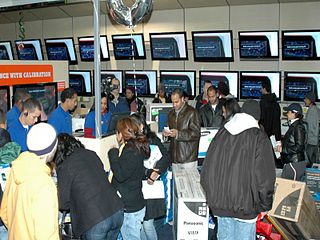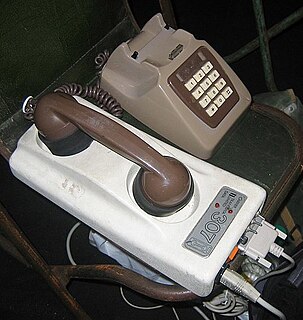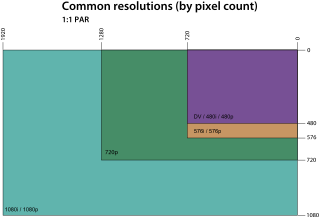
Consumer electronics or home electronics are electronic equipment intended for everyday use, typically in private homes. Consumer electronics include devices used for entertainment, communications and recreation. In British English, they are often called brown goods by producers and sellers, to distinguish them from "white goods" which are meant for housekeeping tasks, such as washing machines and refrigerators, although nowadays, these would be considered brown goods, some of these being connected to the Internet. In the 2010s, this distinction is absent in large big box consumer electronics stores, which sell both entertainment, communication, and home office devices and kitchen appliances such as refrigerators. Radio broadcasting in the early 20th century brought the first major consumer product, the broadcast receiver. Later products included telephones, televisions, and calculators, then audio and video recorders and players, game consoles, personal computers and MP3 players. In the 2010s, consumer electronics stores often sell GPS, automotive electronics, video game consoles, electronic musical instruments, karaoke machines, digital cameras, and video players. Stores also sell smart appliances, digital cameras, camcorders, cell phones, and smartphones. Some of the newer products sold include virtual reality head-mounted display goggles, smart home devices that connect home devices to the Internet and wearable technology.

Roaming is a wireless telecommunication term typically used with mobile devices, such as mobile phones. It refers to the mobile phone being used outside the range of its home network and connects to another available cell network.
A grey or gray market refers to the trade of a commodity through distribution channels that are not authorized by the original manufacturer or trade mark proprietor. Grey market products are products traded outside the authorized manufacturer's channel.

The N-Gage is a smartphone combining features of a mobile phone and a handheld game system developed by Nokia, announced on 4 November 2002 and released on 7 October 2003. It runs the original Series 60 platform on Symbian OS v6.1.

Interactive television is a form of media convergence, adding data services to traditional television technology. Throughout its history, these have included on-demand delivery of content, as well as new uses such as online shopping, banking, and so forth. Interactive TV is a concrete example of how new information technology can be integrated vertically rather than laterally.

In Japan, mobile phones became ubiquitous years before the phenomenon spread worldwide. In Japanese, mobile phones are called keitai denwa (携帯電話), literally "portable telephones," and are often known simply as keitai.
One or 1 is the first natural number.
In telecommunications, quadruple play or quad play is a marketing term combining the triple play service of broadband Internet access, television and telephone with wireless service provisions. This service set is also sometimes humorously referred to as "The Fantastic Four".

NBA League Pass is a sports television service that features all National Basketball Association games. The service is operated by Turner Broadcasting System on behalf of the NBA. It was made available prior to the start of the 1995-1996 NBA season. It is available to viewers in the United States and as an international package for all other countries. The pricing structure and services on offer are different, depending on where the viewer is located. The 2013-14 season was the 20th year of League Pass. Full League Pass access for the 2014-15 season was priced at $199 for US customers, for comparison the premium service was £169.99 for UK viewers.
Media is the communication outlets or tools used to store and deliver information or data. The term refers to components of the mass media communications industry, such as print media, publishing, the news media, photography, cinema, broadcasting, digital media, and advertising.

A modem – a portmanteau of "modulator-demodulator" – is a hardware device that converts data from a digital format, intended for communication directly between devices with specialized wiring, into one suitable for a transmission medium such as telephone lines or radio. A modem modulates one or more carrier wave signals to encode digital information for transmission, and demodulates signals to decode the transmitted information. The goal is to produce a signal that can be transmitted easily and decoded reliably to reproduce the original digital data.
The form factor of a mobile phone is its size, shape, and style, as well as the layout and position of its major components.

A feature phone is a mobile phone that retains the form factor of earlier-generation phones, with button-based input and a small display. Feature phones are sometimes called dumbphones in contrast with touch-input smartphones. They tend to use an embedded operating system with a small and simple graphical user interface, unlike large and complex mobile operating systems like Android or iOS. Feature phones typically provide voice calling and text messaging functionality as well as basic multimedia and Internet capabilities and other services offered by the user's wireless service provider. Feature phones often contain hardware including a backlit LCD screen, a hardware notification LED, a micro USB port, a physical keyboard, a microphone, an SD card slot, a rear-facing camera to record video and capture pictures, and GPS. Some feature phones include a rudimentary app store that includes basic software such as mobile games, calendar and calculator programs.

4K resolution refers to a horizontal display resolution of approximately 4,000 pixels. Digital television and digital cinematography commonly use several different 4K resolutions. In television and consumer media, 3840 × 2160 is the dominant 4K standard, whereas the movie projection industry uses 4096 × 2160.

The graphics display resolution is the width and height dimension of an electronic visual display device, such as a computer monitor, in pixels. Certain combinations of width and height are standardized and typically given a name and an initialism that is descriptive of its dimensions. A higher display resolution in a display of the same size means that displayed photo or video content appears sharper, and pixel art appears smaller.
An over-the-top is a streaming media service offered directly to viewers via the Internet. OTT bypasses cable, broadcast, and satellite television platforms, the companies that traditionally act as a controller or distributor of such content. It has also been used to describe no-carrier cellphones, where all communications are charged as data, avoiding monopolistic competition, or apps for phones that transmit data in this manner, including both those that replace other call methods and those that update software.

The history of videotelephony covers the historical development of several technologies which enable the use of live video in addition to voice telecommunications. The concept of videotelephony was first popularized in the late 1870s in both the United States and Europe, although the basic sciences to permit its very earliest trials would take nearly a half century to be discovered. This was first embodied in the device which came to be known as the video telephone, or videophone, and it evolved from intensive research and experimentation in several telecommunication fields, notably electrical telegraphy, telephony, radio, and television.










